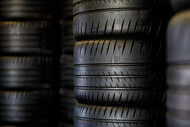
Tips & Advice for Car, SUV & Van tires
On what basis should you compare tires to select the one that will give you complete satisfaction? This article is about the main performance criteria to consider, the decision aids you can use and Michelin's best advice. We will discuss how to select the one you need within the same tire line and provide you with decision aids, such as independent tire tests, labelling and tire comparison sites. Finally, we will discuss another important criterion: long term performance.
The main performance criteria for tire comparison
To ensure effectiveness, tires need to deliver numerous, often conflicting, performance characteristics. Improving one of these performances must not be to the detriment of the others.

Traction or grip
Remember – the tires are the only contact your vehicle has with the road, so their grip plays an essential role in your safety. Your ability to brake, to turn, to accelerate or to stay stable at higher speeds all depend on your tire’s grip. Each type of tire is designed to provide grip in specific types of weather and road conditions. That’s why it’s so important to think about how and where you will be driving and what type of grip you’ll need when you choose your tires.

Longevity
How long a tire lasts before wearing out its tread is an important element to ensure you are getting the best value for your money. There can be huge differences in the tire mileage you will receive based on the tire's design and quality of the tire. Sport tires (high performance tires) tend to have lower tread life than standard passenger car tires because the focus of the design is grip and performance instead of longevity. How and where you drive and whether or not you take care of your tires will also impact how long they last.

Energy efficiency
Did you know that 1 out of every 5 tanks of a vehicle’s fuel is due to the tires’ rolling resistance on the road? Tires can have a big impact on your vehicle’s fuel consumption. Some tires have specific construction and materials that help to reduce the rolling resistance. Buying energy efficient tires that offer low rolling resistance can help you save on fuel or extend your battery range for electric vehicles. Another way to give you good value for money.

Handling
Handling is how your vehicle responds to the demands of the driver (such as steering, accelerating, braking) and to road conditions. Great handling tires can enhance safety – by keeping the vehicle stable and the driver in control – as well as driving pleasure. The tire plays a very important role in handling: It transmits the driver’s instructions from the wheel to the ground. In general, sporty high-performance tires are designed to maximize handling performance and deliver precise steering and cornering.

Comfort and Noise
Driving comfort refers to how the tire cushions the driver from the irregularities of the road. Tires that are optimized for better comfort have specially designed construction to help absorb bumps and provide a smooth ride. Another important element for an enjoyable drive is a quiet ride. This is determined by a tire’s tread design – the amount of grooves in the tire and their positions. In general, the more aggressive a design looks, the higher the probability that it may generate noise. But remember that the grooves have an important role to play in delivering grip – decide if that additional traction is worth a little more road noise.

Robustness
Tyres need to be able to resist whatever the road brings. A tire’s robustness, or toughness, is its ability to overcome everyday road hazards. If you often drive on damaged or unpaved roads, look for tires with reinforced construction.

Long lasting performance
Whatever performance criteria are considered, it is important that they last throughout the life of the tire. This means not just comparing tyres when they are new, but ensuring that they continue to perform throughout their life cycle until they reach the wear indicators. A tyre should perform well from the first kilometer to the last.
How to compare tires within the same tire line?
Each of our tire lines is made in a selection of sizes to fit appropriate vehicles.
Sometimes a tire line will have several versions of the same tire size but with different technical specifications such as :
- Speed ratings (ex: S, T, H, V, W, Y, etc.),
- Load index (ex : 91, 94, XL, etc.),
- OE markings (Original Equipment).

These technical specifications are important details that can determine whether or not that version is compatible with your vehicle and the way you drive.
If several versions are compatible with your vehicle, we recommend that you choose the version with the same specifications as your original equipment tires, including the correct OE marking.
The OE marking concerns tires developed in cooperation with car manufacturers that meet more specific requirements, proper to each car brand. For example, the "MO" marking means that the tire is approved by Mercedes for its vehicles.
However, the OE marking is not a requirement as long as the size, speed, and load indexes are respected.
You can also safely select a version with higher speed rating or load index; however, higher speed or load capability can negatively impact tread life and ride comfort.
Independent tests to help you compare tires
Independent tire testers such as specialized magazines or professional organisations can help you for your tire comparison.
Each year, these independent testers use very strict criteria to assess the performance of tires by testing them on different surfaces. They evaluate various aspects such as braking, handling, rolling resistance, noise, etc…

Compare tires with tire comparison sites
Using tire comparison sites can be helpful, but it is important to remember that their comparisons are generally based on new tires which means that they do not put the tested tires into perspective beyond a certain level of wear (once they have covered a few thousand miles).
Yet some tire performances become less effective with wear, particularly on wet roads and especially when braking. Therefore, it is also important, when comparing tires, to assess the performance of tires once they start to wear.
Choosing tires with performance made to last
Maintaining the performance of the tire until the very last mile is precisely what Michelin demands of its tire ranges.
In the development and production of our tires, we strive to obtain the best performance without compromise when they are new, and that this performance remains at an excellent level until the very last mile, once the maximum wear level has been reached.

Choose the right tire for your needs
-

Commercial
For light truck and van operators requiring reliability and longevity to help deliver best...
View tires -

Comfort & Luxury
Ride in comfort and silence knowing you and your family will be safe.
View tires -

Sports
For those who enjoy a spirited drive requiring tires made for sports performance.
View tires -

Off Road/4WD
Tires with toughness and dependability to ensure you are safe when off the beaten track.
View tires -

Environmentally Friendly
Save money and protect the environment with eco tires that are designed to reduce energy...
View tires -

Track & Performance
For those who enjoy a spirited drive requiring tires made for sports performance. Tires derived...
View tires



